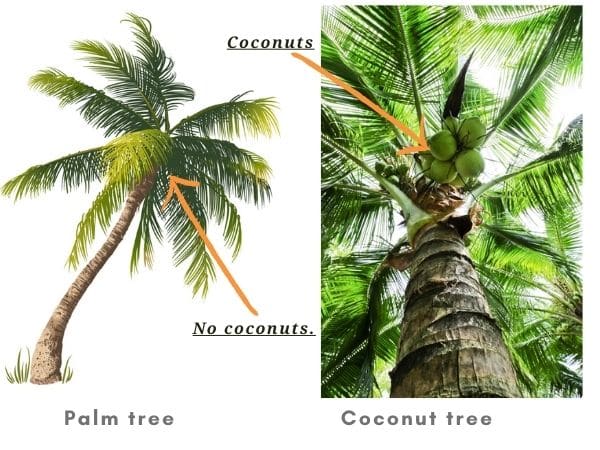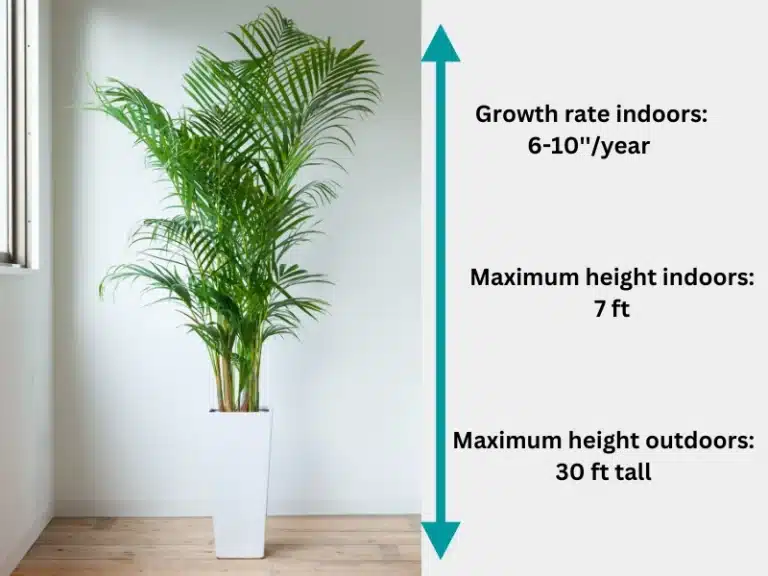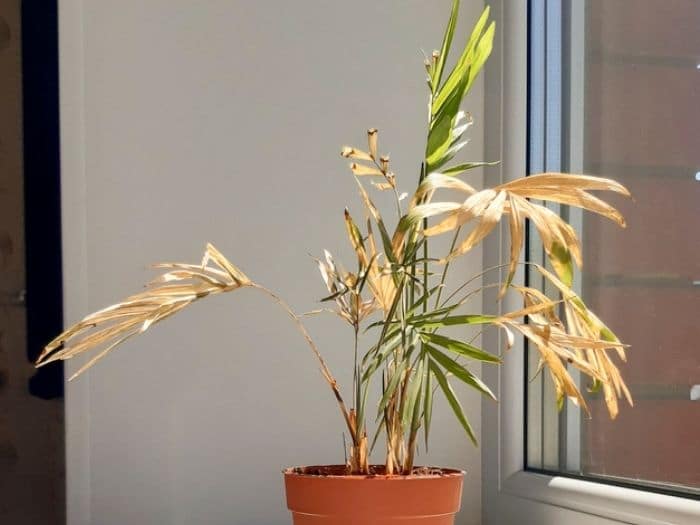Coconut Tree vs. Palm Tree: Differences + Identification
The distinctive characteristics between a coconut tree and a palm tree can be confusing to many. Though there are several species of palm trees, only one type of species can bear coconuts. So, what’s the difference between coconut trees and palm trees?
Coconut trees are a type of palm tree. They have many similarities, but not all palm trees produce coconuts. The main difference is that palm trees have fan-shaped leaves while coconut trees have wide leaves. In addition, coconut trees produce coconuts, while palm trees produce palm oil.

There’s a wide variety of coconuts. Typically, coconut trees look familiar but vary in thickness and size. Most coconut trees have slender trunks and an average height of 80 feet. While the growth of fronds caps the top, the bases are usually thick.
Contents:
Is a coconut tree a palm tree?
‘Palm tree’ is a term that combines all trees under the Palmaceae class, including coconut trees. However, a coconut tree differs in many ways from a palm tree. For example, palm trees do not produce coconuts.
All palm trees are identical in their leaves. They have a type of leaves called palm fronds. These leaves have a fan-like structure and shape, with sections growing outward from a single point. Every palm species has a different length of leaves, with some growing up to 10 feet long.
Coconut Tree vs. Palm Tree – Differences
| Coconut Tree | Palm Tree |
| Bear coconut fruit | Produces palm oil |
| Wide shaped leaves | Fan-shaped leaves |
| Botanically, coconut trees have a lifespan between 60-80 years. The trees are often called three-generation trees because they support father, children, and grandchildren. The trees are slow and bear coconuts between 6-10 years. | Some palm trees last up to 150 years. On average, palm trees have a lifespan of between 7-8 decades. The lifespan of a palm tree is dependent on the species. While some palms live more than a century, those grown in tropical surroundings live between 70 -100 years. |
| Coconut trees are deep-rooted. | Palms roots spread on the base up to 36 inches deep. |
| Coconut trees grow best in wet and hot tropical climates. They require adequate moisture and warmth to grow well. | Plam trees do better in warm tropical climatic conditions. Though hardy and suit various climatic conditions, they are easily affected by extremely cold temperatures during winter. |
Comparatively, coconut palms and palm trees grow in different climatic conditions. This contributes to the disparities in characteristics and features. While the coconut tree is known to produce coconut, palm trees exist in different types and sizes. Though palm trees belong to the same family, they differ in several ways.
Despite many coconut trees, the coconut palm is the only type of palm that produces coconuts.
Do coconuts grow on palm trees?
Despite palm trees belonging to the same family, only one species of palm tree bear coconuts. However, several species of coconut trees are in existence.
Cocos nucifera is the only type of palm species that produces coconuts. Others are known to produce palm oil, and others are unrelated to coconuts. The lookalike nature of a palm and coconut tree makes people assume both produce coconuts. The fact is that there are two different species of the palm tree.
What type of palm tree has coconuts?
Cocos nucifera palm species is the only type of palm tree that produces coconuts. This is the only surviving species of the genus coco. Further, there are two categories of coconut trees;
- Tall coconut tree
- Dwarf coconut tree
Within the two categories of coconut trees, there are several varieties of coconut trees. The trees are different depending on the locations they can be found. In that regard, the coconut produced by the trees varies in color, size, and shape.
This is dependent on the age and health of a coconut tree. On another twist, there are over 80 varieties of coconut trees in this category. Despite having only one species of coconut tree, there are several different kinds of coconut-producing trees.
Starting with the taller coconut variety, it differs from the shorter variety in many ways. The taller version can cross-pollinate. This means it can share generic information with other trees.
That said, its flowers rely on pollination from other trees to reproduce. Hence, the reason why two types of palm trees exist (tall, and dwarf) but produce different coconuts.
Here’s a list of palm trees that produce coconuts:
- West coast Tall coconut: can grow in any type of soil and produces 80 coconuts annually
- East coast Tall coconut – grows in sandy soil and bears 70 coconuts annually
- Macapuno coconut – highly nutritious and grows in deserts
- Malayan yellow dwarf coconut – a common dwarf coconut that produces the highest number of coconuts in the history of palm trees
- Maypan coconut – resistant to cold and grows large-sized coconuts. It also resists yellowing disease
- King coconuts – are in color and grow in clusters of 30.
- Fiji dwarf coconut has long fronds and is highly resistant to disease. They are highly admired in various quarters.
How to identify a coconut tree
Coconut trees can be identified in many ways. Though coconut trees have many distinctive characteristics, they have common features that can easily be identified.
- The columnar trunk is usually 15-17 feet long.
- 4 feet wide feathery-shaped leaves
- Fibrous covered fruit
- They have a slender, textured trunk.
- Most coconut tree species rise to a height of up to 80 feet.
- The top is capped by the growth of fronds, and the base is thick.
Palm tree identification
Though a coconut tree and a standard palm tree may have almost the same features, you can identify a palm tree through the following features.
- Leaves have fan-like fronds
- Some species have long, slender single trunks
- Dwarf variety of palm trees have short fat palm trunks
- Smaller palm trees have clustered trunks with 3-4 trunks growing together
- Some dwarf palm trees have bushy pinnate fronds that pop out without any trunk
- Some palm trees have smooth, slender trunks.
None of these plants produce good palm tree wood that can be used for firewood.
The unique aspect is that most homeowners grow dwarf and shorter palm varieties in their yards due to the shallow roots of palm trees.
The following are the common types of dwarf, bushy and small palms preferred by most households.
Pygmy Date Palm
This is a small-sized palm that doesn’t grow taller than 10ft. It can easily be identified through the single stem with bushy pinnate-shaped fronds. The tree is a common ornamental flowering tree ideal for subtropical landscaped gardens. Though the plant bears dates, the fruit is not as tasty as those that grow in taller palm trees.
Pindo Palm
Commonly known as jelly palm, the palm tree is a species of cold-hardy palms. They are usually slow in growth rate and can hit around 20ft when fully mature.
This indicates they are ideal for gardens that require shorter palm trees. The unique aspect of this species is that they grow in any type of soil and are tolerant of full sun.
Triangle Palm
Commonly known as Dypsis decaryi palm, it fits small to medium size palms that can be used for a small garden. One can identify the palm tree through the pinnate fronds that grow up to 8ft. An exciting feature about the fronds is that the leaves point at 120 degrees. This gives the palm tree a triangular shape at the cross-section. The ornamental type of palm tree is ideal for tropical gardens
Mediterranean Dwarf Palm
Commonly known as the Mediterranean palm tree, it is a species of flowering palm. it has clustered trunks which makes the palm tree look like a shrub. The palm tree grows in warm climates at an average height of 20ft. It is valued for its ornamental outlook, cold hardiness, and great colors.
Overall, palm trees look similar but differ in various ways.




Hello Alex, in your article above https://gardenine.com/coconut-tree-vs-palm-tree/,
you have a heading saying, “Here’s a list of palm trees that produce palm trees:”
Do you mean to say, “Here’s a list of palm trees that produce COCONUTS”?
Thank you
Oh yes. Thank you for the observation. I’ve since corrected.